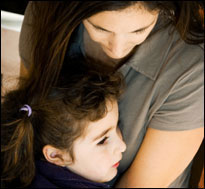The birthrate for single mothers in the United States was 80% higher in 2007 than it was in the 1980s, and that rate accelerated in the early 2000s, according to data from the U.S. Census Bureau. Nearly four in 10 children (36%) are now born to unwed parents. Research suggests that the increased number of single-parent households is related to greater acceptance of sexual activity outside of marriage, an improved ability for women to provide for themselves and less stigmatization of divorce.
The recent recession has increased pressure on single parents as well as couples with children. While 9% of married families are now living below the poverty line and receiving food stamps, single mothers are four times as likely to be in the same situation. Still, the rate of marriage continues to fall: In 2010 married couples made up just under 50% of all households; now they compose 48.6%.
What does having single parents mean for the next generation of kids? Much of the existing research points to a higher prevalence of substance abuse and increased risky behavior, as well as poorer school performance, among children of single parents. Yet when kids move beyond their teenage years and into adulthood, the consequences of single parenthood are largely unstudied.
To fill this gap in research, Leonard M. Lopoo of Syracuse University and Thomas DeLeire of Georgetown University analyze data from the Panel Study of Income Dynamics to determine the effect of family structure on childen’s income and education level once they reach adulthood. In a 2013 study, “Family Structure and the Economic Well-being of Children in Youth and Adulthood,” published in Social Science Research, they draw conclusions about the long-term outcomes produced by certain family types.
The study’s findings include:
- Initially, divorce and single parenthood appear to lead to diminished lifelong outcomes for children. However, “once we control for the child’s demography and economic wellbeing in childhood, the association between family structure in the child’s youth and the child’s economic wellbeing in adulthood disappear, suggesting that the consequences of family structure on long-term outcomes of children are largely the result of economic experiences in childhood.”
- Remarriage seems to have a “protective effect” on children of divorced mothers: “All children have greater resources available to them later in their childhood, but the children of mothers who have dissolution and remarry have more resources available per capita than the children of continuously married or the children of never remarrying mothers.”
- Children of remarried mothers do not fare as well as those whose parents stayed married in terms of certain later-life outcomes, including education and engagement in risky behaviors. While children in remarried families seem to have as much income available as those who stay married, the difference could be due to “the instability of a marital dissolution, where children may have to move into a different neighborhood with different peer networks and schools.”
“Ultimately, then we find no persistent effects of family structure over time, particularly once one controls for the resources available to the child when young,” the scholars conclude. The key factor is family income: When single mothers — or in increasing numbers of cases, single fathers — have fewer financial resources, their children are more likely to be disadvantaged through adulthood. When the resources are available, however, the differences effectively disappear, statistically speaking.
Tags: parenting, family


Expert Commentary